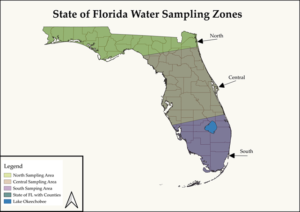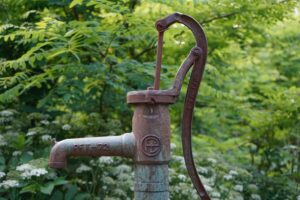
High quality water is essential to any agricultural operation. From small farmsteads to large industrial operations, clean water is needed for day-to-day operations. From irrigation of the crops, to washing hands, water is required. The quality of water is also a critical component to the success of any operation. Across the beautiful State of Florida, the quality of the groundwater and surface water vary. From the decades of industrial agriculture and the lessons learned along the way, a significant portion of the water in Florida has become unsuitable for human and animal consumption. Through its Grant to FIU’s Department of Earth and Environment, the Weo Foundation wanted to bring new statewide data by assessing the well water quality. In this study conducted by Florida International University’s Conservation and Sustainable Horticulture Lab, entitled “Water Quality Assessment in Florida’s Ag. Sector”, thirty-nine farm-used groundwater wells across the State of Florida were analyzed in active farms and homesteads to assess the quality of groundwater that is used for agricultural purposes. We analyzed the physical parameters (e.g., pH and Oxidation-Reduction Potential (ORP), Heavy metals, inorganic nonmetals (e.g., Nitrate and Phosphorus), volatile organic compounds (e.g., pesticides and petroleum compounds), and microbiological contaminants (e.g., coliform and Escherichia coli).
Quality of Agricultural Water
It is known that certain contaminants such as pesticides and heavy metals negatively impact the health of the individuals and animals that ingest them. It is also known that some of these contaminants may also be found in fruit and vegetable products produced with contaminated water. Additionally, Coliform microorganisms can hitch a ride on a farmer’s hand or on the fruit of an irrigated tree, potentially causing illness in the consumer. Therefore, it is necessary to know the quality of the water prior to its use and intermittent monitoring during its use.
Surface waters such as lakes and canals can be contaminated the quickest; runoff from fields and roadways can rapidly enter the water and be carried downstream. The relatively fast flow rate can move the contaminants over large distances over a short period of time. Groundwater contamination occurs over longer periods of time since the contaminants must flow through the soil and limestone barriers. Sometimes these contaminants are stopped by these barriers and do not enter the water supply in significant quantities. Consequently, these soils and stones are contaminated and may still leach contaminants into the water supply over time or into the plant tissue. Contamination of surface water tends to have a visual indicator: dead fish or plants on the surface and shoreline. Groundwater contamination is much more subtle or with no indication whatsoever. That is why groundwater testing is so important.
Regions of Water Quality

The study focused on three broad regions of Florida, grouped by geographic area. These regions were North, Central and South as indicated by the above map. Each region has its own combination of crops, animals, urban density, and unique challenges to water quality.
Northern Region
The Northern region is represented by a total of sixteen samples primarily from animal farms and urban agriculture across the region. We found that over half of the farms sampled had some level of microbiological contamination which can cause illness or death in humans and animals. Three of the farms had E. coli contamination, one had Nitrate above the EPA safe limit, and a single farm had Naphthalene in the water supply. Physical parameters are within the expected ranges, with only a few exceptions. All wells are within the freshwater range of salinity, though a few are critically elevated, potentially indicating ongoing saltwater intrusion.
Central Region
The Central region is represented by ten total samples consisting of urbanized agriculture and wetland area. Out of the farms sampled sixty percent had Coliform contamination and two farms had additional E. coli. Beyond that, the other tested categories came back clear. Salinity, and Total Dissolved Solids were significantly elevated in some cases which can be indicative of saltwater intrusion. Saltwater intrusion is the process of which oceanic saltwater seeps into the groundwater system, contaminating it, and greatly reducing what it can be used for.
South Region
The South Region is represented by thirteen samples, characterizing the beating heart of Florida’s horticultural and urban areas. This region contains the Florida Everglades and the City of Miami; these areas contain some of the richest mix of tropical plants and specialty crops, in addition to run-of-the-mill row crops. Well over sixty percent of the farms sampled had some level of coliform contamination and one of which even tested positive for E. coli. One farm tested positive for low-level lead, which we believe is an isolated case and not truly representative of the region. Physical parameters were all within the safe range and none were near elevated levels beyond expectations.
Key Take-Aways
Florida is as diverse as the plants that thrive in its lands and the water is no different. Each region has its own unique challenges in acquiring clean, healthy water. The chief problem we saw was categorically biological: Coliform contamination and E. coli. Well over half of the farms tested had some level of biological contamination and fewer yet had unacceptable levels of illness-causing E. coli. This should not be an issue in today’s day and age and requires action to prevent illness, and in severe cases, death. We hope that our findings increase awareness of this problem and lead to a solution that benefits all.
By Daniel Tucker, Bishnu Pandey and Dr. Amir Khoddamzadeh .
References
- Virginia Bioinformatics Institute ; 2009; Pathogen Information (PathInfo); http://pathport.vbi.vt.edu/pathinfo/pathogens/E.coli_O157H7_Info.shtml; As posted on September 1, 2009. Virginia Bioinformatics Institute Blacksburg, VA 24061
- https://tdb.epa.gov/tdb/contaminant?id=10100
- Avery L., Williams A., Killham K., Jones D.; 2008; Survival of Escherichia coli O157:H7 in waters from lakes, rivers, puddles and animal-drinking troughs; Science of the Total Environment; 389:2-3:378
4.https://www.health.state.mn.us/diseases/ecoli/index.html#:~:text=More%20than%20700%20serotypes%20of, cramps%2C%20bloody%20diarrhea%20and%20vomiting.
- https://www.cdc.gov/ecoli/index.html
- https://www.epa.gov/system/files/documents/2021-07/parameter-factsheet_e.-coli.pdf 7. https://doh.wa.gov/sites/default/files/legacy/Documents/Pubs//331-181.pdf
8.https://archive.epa.gov/water/archive/web/html/vms59.html#:~:text=Conductivity%20is%20measured%20in %20micromhos,50%20to%201500%20%C2%B5mhos%2Fcm.

